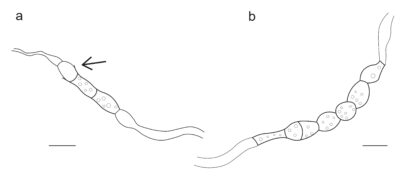Fungalpedia – Note 396, Incertomyces
Incertomyces Egidi & Zucconi
Citation when using this data: Tibpromma et al. 2024 (in prep.) – Fungalpedia, Rock-inhabiting fungi.
Index Fungorum, Facesoffungi, MycoBank, GenBank, Fig. 1
Classification: Incertae sedis, Capnodiales, Dothideomycetidae, Dothideomycetes, Pezizomycotina, Ascomycota, Fungi.
Incertomyces was established by Egidi et al. (2014), with Incertomyces perditus designated as its type species. Utilizing Bayesian analysis of LSU, rpb2, ITS, and BT2 sequences, Egidi et al. (2014) demonstrated that Incertomyces is positioned within the Teratosphaeriaceae. Incertomyces was introduced with two species: I. perditus and I. vagans. Incertomyces species are rock-inhabiting fungi that were isolated from rocks in Monte Rosa, Italy (Egidi et al. 2014, Crous et al. 2019). Initially, the generic name Incertomyces was considered invalid under Article 40.7 (Shenzhen) of the nomenclatural rules, as introduced by Egidi et al. (2014). This issue was later rectified by Crous et al. (2019), who published Incertomyces as a validly established name. Incertomyces is characterized by its slow-growing colonies and an anamorphic stage with thick-walled, torulose and septate hyphae. These hyphae proliferate enteroblastically and become cylindrical in later stages, producing pyriform or reniform arthroconidia, which mostly have a median septum (Egidi et al. 2014, Crous et al. 2019). The sexual morph of Incertomyces remains unknown.
Type species: Incertomyces perditus Egidi & Zucconi
Other accepted species: Species Fungorum – search Incertomyces
Figure 1 – Incertomyces perditus (CBS 136105=CCFEE 5385). a, b Germination of conidia (arrow indicated hyaline hyphae). Scale bars: a, b = 10 μm. Redrawn from Egidi et al. (2014).
References
Entry by
Wanasinghe DN, Center for Mountain Futures, Kunming Institute of Botany, Chinese Academy of Sciences, Honghe 654400, China.
(Edited by Saowaluck Tibpromma, Samaneh Chaharmiri-Dokhaharani, & Achala R. Rathnayaka)
Published online 26 November 2024
